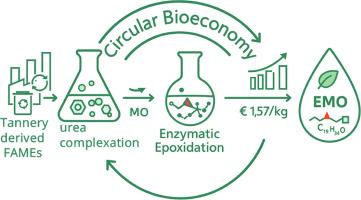Valorization of tannery-derived FAMEs into bio-based epoxides via chemo-enzymatic synthesis
引用次数: 0
Abstract
The urgent transition toward low-carbon chemical manufacturing has prompted the development of renewable alternatives to fossil-based epoxy intermediates. This study presents an integrated and resource-efficient chemo-enzymatic route for the synthesis of epoxidized methyl oleate (EMO) from fatty acid methyl esters (FAMEs) derived from tannery waste—a lipid-rich but underutilized industrial residue. A single-step urea complexation achieved 86.7 ± 0.6 % methyl oleate purity with a 38.1 ± 0.9 % recovery yield, while the saturated-rich co-product (∼40 %) exhibited physicochemical properties suitable for biodiesel or lubricant applications.
Subsequent epoxidation was carried out using immobilized Candida antarctica lipase B (Novozym® 435) and in situ generated performic acid, yielding an oxirane oxygen content of 6.42 ± 0.14 %, corresponding to >90 % conversion of double bonds under mild conditions. The enzyme retained 72 % of its initial activity after ten reuse cycles, significantly enhancing process circularity and reducing catalytic costs.
Green chemistry metrics were favorable: atom economy reached 86 %, solvent recovery exceeded 85 %, and the E-factor remained as low as 0.86 kg waste/kg EMO. A cradle-to-gate life cycle assessment (LCA) estimated a global warming potential (GWP) of 1.92 kg CO₂-eq/kg EMO—representing a 63 % reduction compared to petrochemical benchmarks. Economic analysis at the 1000 t/year scale yielded a production cost of €1.57/kg with an internal rate of return (IRR) of 15 %.
Overall, this work demonstrates how lipid-rich industrial residues can be converted into high-value bio-based epoxides through a scalable and environmentally sound chemo-enzymatic route, aligning with circular economy principles and green chemistry targets.

皮革衍生的FAMEs通过化学酶合成转化为生物基环氧化物
向低碳化工生产的迫切转变促使了可再生替代品的发展,以替代化石基环氧中间体。本研究提出了一种综合且资源高效的化学-酶途径,用于从鞣革废料中提取脂肪酸甲酯(FAMEs)合成环氧化油酸甲酯(EMO)。鞣革废料富含脂质,但未充分利用的工业残渣。单步尿素络合的油酸甲酯纯度为86.7±0.6%,回收率为38.1±0.9%,而富含饱和的副产物(约40%)具有适合生物柴油或润滑剂应用的理化性质。随后使用固定化的南极念珠菌脂肪酶B (Novozym®435)和原位生成的甲酸进行环氧化,得到氧环含量为6.42±0.14%,对应于温和条件下双键转化率为>; 90%。该酶在重复使用10次后仍保持了72%的初始活性,显著提高了工艺循环性,降低了催化成本。绿色化学指标良好:原子经济性达到86%,溶剂回收率超过85%,e因子保持在0.86 kg废物/kg EMO的低水平。从摇篮到闸门的生命周期评估(LCA)估计,全球变暖潜能值(GWP)为1.92千克二氧化碳当量/千克emo,与石化基准相比减少了63%。经济分析显示,1000吨/年的生产成本为1.57欧元/公斤,内部收益率(IRR)为15%。总的来说,这项工作展示了如何通过可扩展和环保的化学酶途径将富含脂质的工业残留物转化为高价值的生物基环氧化物,符合循环经济原则和绿色化学目标。
本文章由计算机程序翻译,如有差异,请以英文原文为准。
求助全文
约1分钟内获得全文
求助全文

 求助内容:
求助内容: 应助结果提醒方式:
应助结果提醒方式:


